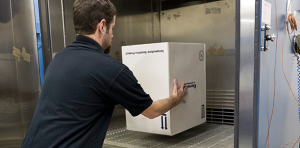At the heart of ASTM F1980 “Standard Guide for Accelerated Aging of Sterile Barrier Systems for Medical Devices” are the Arrhenius equation and Accelerated Aging Factor (AAF) Determination (Sections 6 and 7). Practical use of the AAF involves choosing an aging factor (Q10) which is typically a value of two (2) for packaging testing, an ambient temperature and an accelerated aging temperature. The typical ambient temperature selected ranges from 20 – 25°C. Selection of the accelerated aging temperature involves a little more choice. Temperatures of 50°C, 55°C and 60°C are most common but occasionally engineers choose a higher accelerated aging temperature.
 One way to explain the use of the Arrhenius equation and Accelerated Aging Factor (AAF) Determination to someone outside of the profession is to describe it as a time machine. The use of these equations allows the engineer to essentially make time go faster in order to prove out their packaging that much sooner.
One way to explain the use of the Arrhenius equation and Accelerated Aging Factor (AAF) Determination to someone outside of the profession is to describe it as a time machine. The use of these equations allows the engineer to essentially make time go faster in order to prove out their packaging that much sooner.
Where things can go wrong is when the time machine is abused. Choosing an accelerated aging temperature significantly above the common temperatures of 50°C, 55°C and 60°C in order to obtain test results even quicker can have disastrous results.
Forgetting that the accelerated aging theory is meant for homogeneous materials while most medical devices are comprised of multiple materials can lead to trouble. Understanding the Vicat Softening point for each of the plastic materials in a device is key to picking the proper temperature for aging. Once all of the materials have been identified, identify the material that has lowest softening point. Once this is known, a safe and effective temperature can be utilized for the accelerated aging process.
DDL’s Scott Levy relates a story when he first began his testing career: “I was working with a client that wanted 70°C for his accelerated aging. He was aging some product in a PETG tray. I put the samples into the chamber on a Friday and checked them on the following Monday. To my surprise, some of the materials had melted and others had deformed horribly. Let’s just say that’s when I learned my lesson with accelerated aging. Many years later, I still remember that lesson and always work with customers to ensure they pick the proper temperatures for their accelerated aging projects.”
Bottom line: Research your device’s materials so you don’t abuse the time machine.
Have questions about an Accelerated Aging Project? Please contact us today, or call us at 1-800-229-4235.